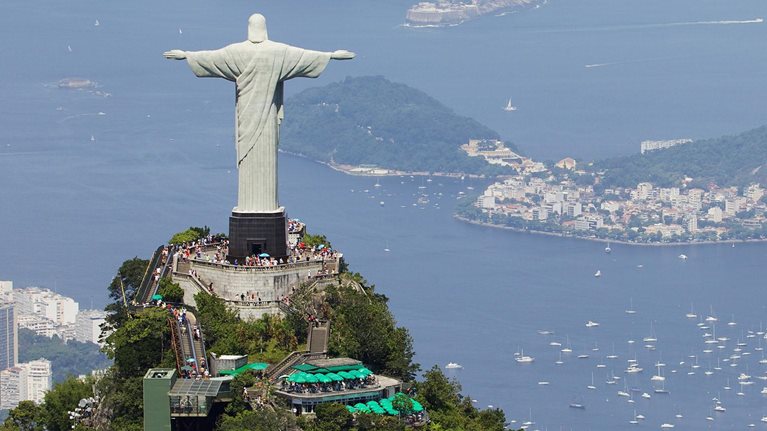Just a few years ago, Brazil was brimming with optimism. Rising global demand for resources led to an export and consumption boom. The official poverty rate was declining sharply, thanks to an expansion of the social safety net and falling unemployment. When GDP growth hit 7.5 percent in 2010, it seemed that the “sleeping giant” was finally wide awake.
Today economic growth has ground to a halt. The aspiring middle class is frustrated by modest income growth, exorbitant prices for consumer goods and sky-high interest rates on household debt. Brazil’s current rate of productivity growth is likely to produce weak 1.2 percent annual gains in per capita income through 2030, which will do little to boost living standards.
The recent slowdown has been exacerbated by Brazil’s long history of insulating itself from the rest of the global economy through a complex system of trade barriers, industry subsidies and high taxes. These measures, along with the country’s chronic infrastructure deficiencies, have not only worsened high prices, they have also sealed off Brazil from the dynamic effects of global competition and prevented it from playing a greater role in the production networks of multinational companies. Brazil’s exports are equivalent to only 13 percent of GDP, far below the level in India (24 percent) or Mexico (33 percent).
As part of the Mercosur trade bloc, Brazil has focused on cultivating South-South trade with other emerging economies, including Israel, India, Cuba, the South African Customs Union, and Egypt. But Brazil exported just over $3.1 billion worth of products to India, the largest of these markets, in 2013. By contrast, a recent study from Brazil’s Instituto de Estudos Para o Desenvovimento Industrial (Institute of Industrial Development Studies—IEDI) estimated that free trade agreements with the EU and the U.S. would boost the country’s foreign trade by 18 percent, or some $86 billion annually.
However, negotiations with the EU have dragged on for more than a decade, and no talks are under way with the United States. As global markets grow ever more connected, Brazil appears to be at increasing risk of being left behind.
Our research finds that Brazil could boost its average GDP growth by up to 1.25 percentage points annually by deepening its global connections. In addition to pursuing new overseas markets, it can accelerate productivity growth by opening up its economy to the pressures of international competition—forcing companies to become more efficient—and cheaper inputs from abroad. Global exposure also expands the supply chain options available to companies and positions them to absorb more of the world’s flows of technology, research and ideas.
This effect can be seen within Brazil’s own economy. In the heavily protected automotive industry, for example, high import tariffs encourage foreign automakers to build cars within Brazil. But the country exports only a small share of the vehicles it produces, and Mexican auto plants now turn out twice as many vehicles per worker as Brazilian plants. Due to high taxes, inefficiencies and import restrictions, the sticker price for a Toyota Corolla is 150 percent higher in Brazil than in the U.S., even though the car is assembled in Brazil.
In contrast, Brazil’s innovative aerospace and agriculture sectors are both thriving in the face of global competition. One critical difference in these cases was a strategy of developing R&D muscle before reducing the government’s direct role in these sectors.
Building deeper global connections is not only about the trade of goods. It is also about benefiting from global flows of finance, services, people, and data. Although Brazil attracts strong inflows of foreign direct investment from companies eager to sell to its large domestic market, it can do more to attract venture capital from overseas to support innovative start-ups. Brazil captures very little of the world’s trade in services.
One of those areas is in tourism. Since 1999, the country has lost 30 percent of its share of world tourism. It can reverse that decline by building tourism infrastructure, improving security, and more effective marketing to global travelers. The increased attention and goodwill likely to come out of hosting the World Cup and the 2016 Summer Olympics provide a unique opportunity to recapture and expand that market.
The migration of workers and the exchange of international students directly translate into new ideas, innovation and business deals. Today only 0.5 percent of Brazil’s workforce is foreign-born; making it easier to obtain work permits would allow companies to recruit skilled foreign talent.
To connect with the rest of the world, Brazil will have to dismantle some homemade barriers to growth, starting with its maze of bureaucracy and its byzantine tax code. It will also need to prioritize building a twenty-first century transportation network that can speed the movement of goods and people, as well as provide greater digital connectivity for the entire population.
The optimism that once surrounded Brazil was more than just hype. The country has diverse and abundant natural resource endowments. Its sophisticated business sector has a strong track record for innovation in fields ranging from clean energy to electronic payment systems, and its large and growing consumer market can fuel the growth of startups. Publicly supported startup hubs in Minas Gerais, Santa Catarina, Pernambuco, and Rio de Janeiro have sparked entrepreneurship in those states. Some of the newly formed companies are already exporters of both goods and contract services.
Brazil needs a new catalyst for growth that can build on these assets. That catalyst could be found beyond its own borders.
This article originally ran in Americas Quarterly.


